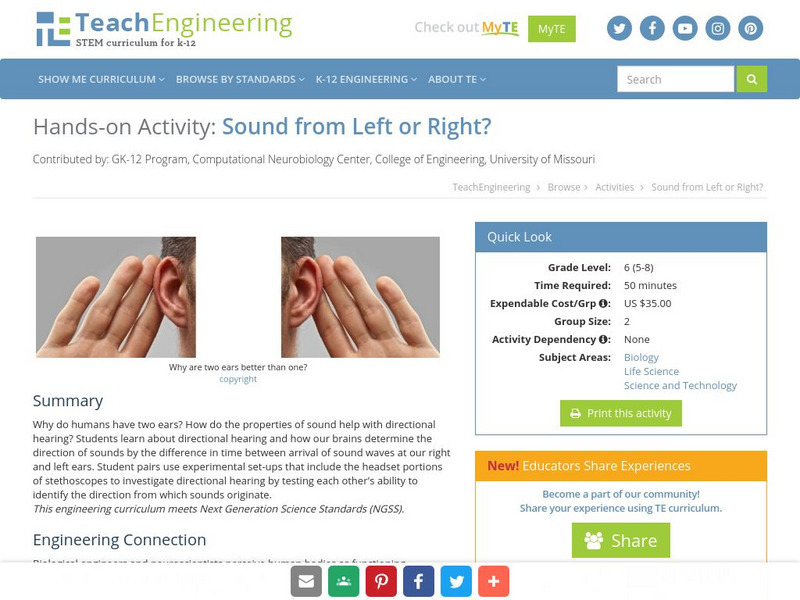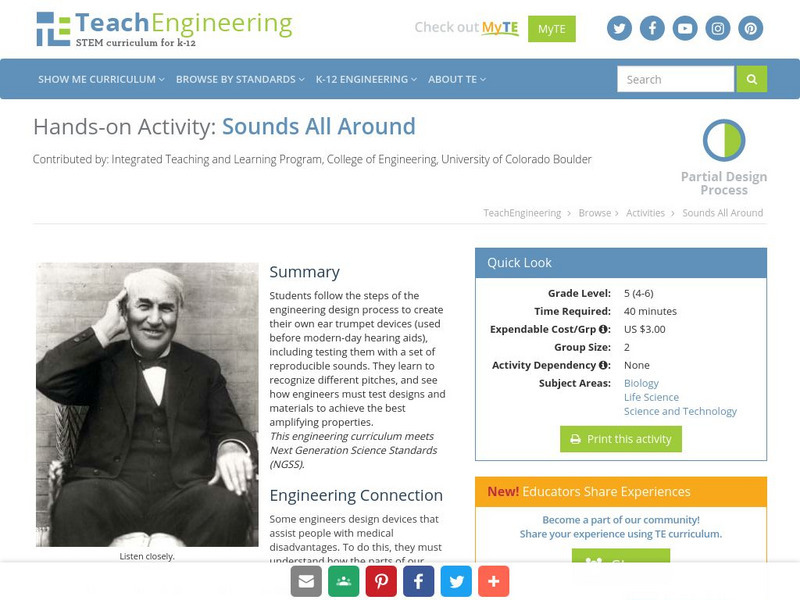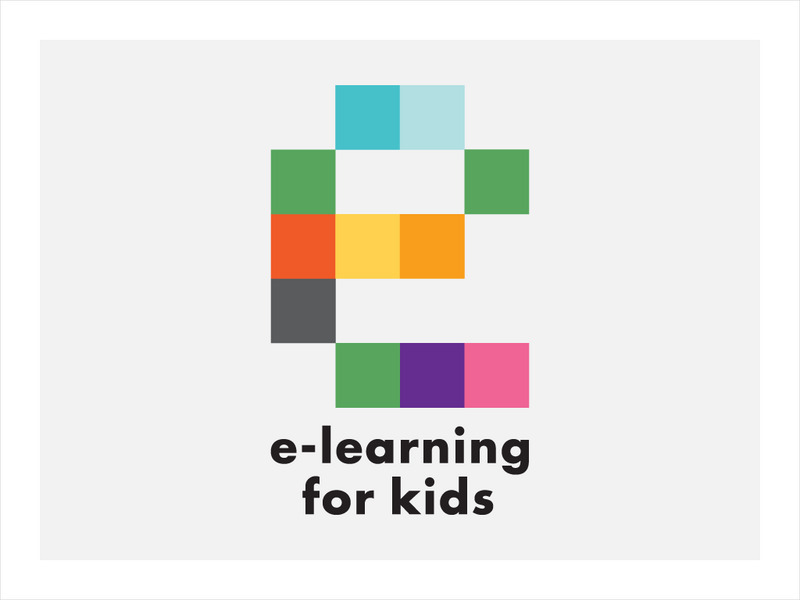Hi, what do you want to do?
CK-12 Foundation
Ck 12: Life Science: Hearing and Balance
[Free Registration/Login may be required to access all resource tools.] What do listening to music and riding a bike have in common? It might surprise you to learn that both activities depend on your ears. The ears do more than just...
CK-12 Foundation
Ck 12: Physical Science: Hearing and the Ear
[Free Registration/Login may be required to access all resource tools.] Explains how we hear sound, how the ear works, and the different structures of the ear.
Georgia State University
Georgia State University: Hyper Physics: Sound Level Measurement
Home page for a hypertext physics course. Users can access subjects ranging from the sound wave parameters that effect hearing and communication to OSHA worplace standards.
TeachEngineering
Teach Engineering: Sound From Left or Right?
Why do humans have two ears? How do the properties of sound help with directional hearing? Students learn about directional hearing and how our brains determine the direction of sounds by the difference in time between arrival of sound...
Unite for Literacy
Unite for Literacy: Healthy Me: I Hear
Look at all the things a child can hear and listen to each day. Book includes audio narration in 19 additional languages with text in English.
Alabama Learning Exchange
Alex: Do You Hear What I Hear?
Learners will perform an investigative activity in which they will identify sounds. The teacher will play several different sounds through the computer and sound system. Students will listen and act as "detectives" to relate sounds to...
Texas Education Agency
Texas Gateway: Physics of Hearing: Conceptual Questions
This is a list of 15 questions based on the major concepts presented in Chapter 17: Physics of Hearing from the AP Physics online text.
Texas Education Agency
Texas Gateway: Physics of Hearing: Problems and Exercises
This is a list of 84 problems and exercises to solve based on the content of Chapter 17: Physics of Hearing from the AP Physics online text.
TeachEngineering
Teach Engineering: How Does a Sound Sensor Work?
Students learn about how sound sensors work, reinforcing their similarities to the human sense of hearing. This lesson and its associated activity enable students to appreciate how robots can take sensor input and use it to make...
Texas Education Agency
Texas Gateway: Physics of Hearing: Sound
describe sound as a longitudinal wave.By the end of this section, you will be able to define sound and hearing and
Georgia State University
Georgia State University: Hyper Physics: Sound and Hearing
Home page for a hypertext course on physics. Accesses a range of topics from hearing to sound measurement to sound propoation to musical instruments.
University of Colorado
University of Colorado: Ph Et Interactive Simulations: Sound
This simulation lets you see sound waves. Adjust the frequency or volume and you can see and hear how the wave changes. Move the listener around and hear what she hears.
Read Works
Read Works: Now Hear This
[Free Registration/Login Required] An informational text about high-pitch sounds that can be heard by children but not by adults. A question sheet is available to help students build skills in understanding cause and effect.
PBS
Pbs Teachers: Scientific American: Calls of the Wild: Flies and Stereo
Explore the characteristics of binaural hearing and discover how two ears are utilized in determining the direction of a sound's origin. Produce auditory illusions by reversing and extending the detection site for each ear.
Texas Education Agency
Texas Gateway: Physics of Hearing: Summary
This page provides a summary of the content of each section of Chapter 17: Physics of Hearing from the AP Physics online text.
E-learning for Kids
E Learning for Kids: Science: Seychelles: How Do We Hear?
This lesson teaches students about how sound vibrations are transmitted through solids, liquids, and gases, and about how materials may absorb sound.
TeachEngineering
Teach Engineering: Sounds All Around
Students follow the steps of the engineering design process to create their own ear trumpet devices (used before modern-day hearing aids), including testing them with a set of reproducible sounds. They learn to recognize different...
TeachEngineering
Teach Engineering: Hearing: How Do Our Ears Work?
Students learn about the anatomy of the ear and how the ears work as a sound sensor. Ear anatomy parts and structures are explained in detail, as well as how sound is transmitted mechanically and then electrically through them to the...
Other
Noise: A Hazard for the Fetus and the Newborn
A research paper on the effects of noise pollution on the unborn and the newborn. Prepared by the American Academy of Pediatrics.
TeachEngineering
Teach Engineering: Human and Robot Sensors
Students are provided with a rigorous background in human "sensors" (including information on the main five senses, sensor anatomies, and nervous system process) and their engineering equivalents, setting the stage for three associated...
E-learning for Kids
E Learning for Kids: Science: Antarctica: Which Types of Sounds Do You Know?
For this lesson, students learn about the five senses, identify objects that make sound, and take a fun fact quiz at the end.
Texas Education Agency
Texas Gateway: Physics of Hearing: Doppler Effect and Sonic Booms
By the end of this section, you will be able to define Doppler effect, Doppler shift, and sonic boom; calculate the frequency of a sound heard by someone observing Doppler shift; and describe the sounds produced by objects moving faster...
Sophia Learning
Sophia: Vocab Tip: Hear It Said Out Loud
This video lesson focuses on the strategy of hearing unfamiliar vocabulary said aloud. The advantages of hearing it said aloud include activating prior knowledge and the brain remembering it better. It offers ways to learn the...
University of New South Wales (Australia)
University of New South Wales: School of Physics: Physclips: Human Sound
Get all the information you need to know about human sound in this learning module. Module covers voice production, ear's part in hearing, resonances, and pitch.
Other popular searches
- Sound and Hearing
- Science Sound and Hearing
- Hearing and Sound Experiment
- Sound and Hearing Worksheets




























